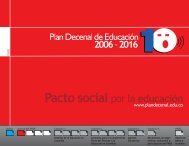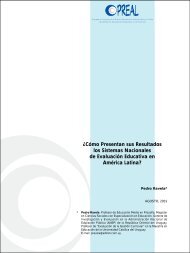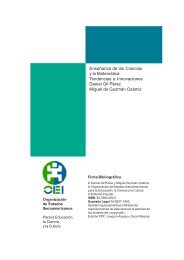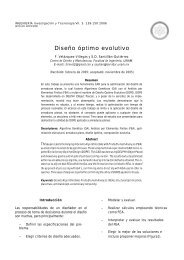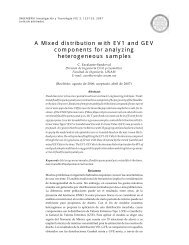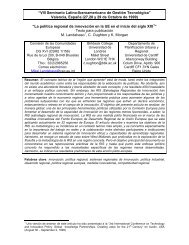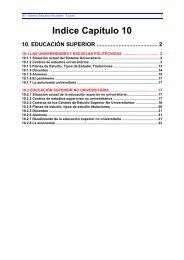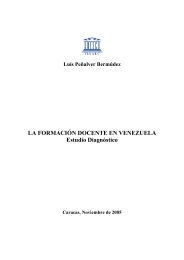The Evaluation of Local Policy Making in Europe - OEI
The Evaluation of Local Policy Making in Europe - OEI
The Evaluation of Local Policy Making in Europe - OEI
Create successful ePaper yourself
Turn your PDF publications into a flip-book with our unique Google optimized e-Paper software.
<strong>Evaluation</strong><br />
Copyright © 1999<br />
SAGE Publications (London,<br />
Thousand Oaks and New Delhi)<br />
[1356–3890 (199910)5:4; 439–457; 011767]<br />
Vol 5(4): 439–457<br />
<strong>The</strong> <strong>Evaluation</strong> <strong>of</strong> <strong>Local</strong> <strong>Policy</strong> <strong>Mak<strong>in</strong>g</strong><br />
<strong>in</strong> <strong>Europe</strong><br />
Learn<strong>in</strong>g from the LEADER Community Initiative<br />
ELENA SARACENO<br />
Ricerche Economico-Sociali (CRES), Italy<br />
Two recent evaluation studies undertaken for the <strong>Europe</strong>an Commission,<br />
related to the LEADER Community Initiative implemented throughout the<br />
1990s, have provided the basis for the issues discussed <strong>in</strong> this article. This<br />
programme was set up to encourage pilot experiences <strong>in</strong> the promotion <strong>of</strong><br />
rural development <strong>in</strong> the problem areas <strong>of</strong> <strong>Europe</strong>, by <strong>in</strong>troduc<strong>in</strong>g a set <strong>of</strong><br />
dist<strong>in</strong>ctive features emphasiz<strong>in</strong>g the method by which local development is<br />
implemented, rather than <strong>in</strong>dividual actions. <strong>The</strong> article argues that<br />
development policies with a territorial approach, locally def<strong>in</strong>ed objectives,<br />
strategies and actions, and <strong>in</strong>volv<strong>in</strong>g the participation <strong>of</strong> several levels <strong>of</strong><br />
government, have a different set <strong>of</strong> underly<strong>in</strong>g assumptions and cannot be<br />
evaluated with the same tools and concepts that are commonly used <strong>in</strong><br />
conventional evaluations. Four ma<strong>in</strong> methodological problems are<br />
discussed: how to def<strong>in</strong>e and assess the dist<strong>in</strong>ctive features <strong>of</strong> LEADER<br />
<strong>in</strong>dividually and as a whole; how to relate such features to development<br />
factors; how to ensure the comparison and aggregation <strong>of</strong> <strong>in</strong>dividual<br />
programmes at national and <strong>Europe</strong>an level; and how to assess and<br />
produce relevant evaluation <strong>in</strong>formation for different governmental<br />
stakeholders. <strong>The</strong> conclusions stress the need to go beyond the<br />
accountability logic <strong>of</strong> conventional evaluations and argue <strong>in</strong> favour <strong>of</strong><br />
provid<strong>in</strong>g more substantial feedback on the effectiveness <strong>of</strong> local policy<br />
mak<strong>in</strong>g for the promotion <strong>of</strong> development, the types <strong>of</strong> contexts <strong>in</strong> which<br />
the dist<strong>in</strong>ctive features <strong>in</strong>troduced by LEADER work best and the<br />
comparison <strong>of</strong> experiences and processes evaluated.<br />
Introduction<br />
Development policies have recently been characterized by a territorial, <strong>in</strong>tegrated<br />
approach (as opposed to <strong>in</strong>terventions by sector), the participation <strong>of</strong><br />
several levels <strong>of</strong> the public adm<strong>in</strong>istration (<strong>in</strong>stead <strong>of</strong> a s<strong>in</strong>gle adm<strong>in</strong>istration) and<br />
locally def<strong>in</strong>ed objectives and strategies, mak<strong>in</strong>g the various plans f<strong>in</strong>anced under<br />
one programme extremely heterogeneous. <strong>The</strong> LEADER Community Initiative,<br />
439
<strong>Evaluation</strong> 5(4)<br />
launched by the <strong>Europe</strong>an Union <strong>in</strong> 1991 to promote rural development, is a good<br />
example <strong>of</strong> this <strong>in</strong>novative approach.<br />
This article argues that such policies make different assumptions about factors<br />
<strong>in</strong>fluenc<strong>in</strong>g economic development and cannot be evaluated with the same concepts<br />
and tools that have been developed for homogeneous, s<strong>in</strong>gle adm<strong>in</strong>istration,<br />
top-down policies. <strong>The</strong> underly<strong>in</strong>g assumption is that development<br />
processes <strong>in</strong>volve a different mix <strong>of</strong> relevant factors that are unique and typical<br />
<strong>of</strong> a particular geographical space and time; therefore they cannot be replicated<br />
<strong>in</strong> other contexts and should be conceived <strong>of</strong> at local level.<br />
<strong>The</strong> evaluation <strong>of</strong> these new forms <strong>of</strong> tailor-made policy mak<strong>in</strong>g has to acknowledge<br />
and understand these different characteristics and def<strong>in</strong>e them and their<br />
expected results precisely, <strong>in</strong> order to be able to measure achievements <strong>in</strong> relation<br />
to more traditional approaches. <strong>The</strong> most common practice <strong>in</strong> the evaluation<br />
<strong>of</strong> these new programmes is to apply the same conventional method used to<br />
measure sectoral <strong>in</strong>terventions conceived with<strong>in</strong> a s<strong>in</strong>gle adm<strong>in</strong>istration and<br />
applied homogeneously <strong>in</strong> different sites. Even though some dissatisfaction has<br />
been expressed about specific aspects <strong>of</strong> such an approach (Pawson and Tilley,<br />
1997; Rieper and Toulemonde, 1997), there is no shared consensus with<strong>in</strong> the<br />
evaluation community on how to deal with these differences.<br />
Two recent evaluation studies 1 undertaken for the <strong>Europe</strong>an Commission have<br />
provided an opportunity to focus the problems posed by the evaluation <strong>of</strong> local<br />
policy mak<strong>in</strong>g, from a conceptual as well as a methodological perspective. <strong>The</strong><br />
first <strong>of</strong> these studies consisted <strong>of</strong> the ex post evaluation <strong>of</strong> 217 local development<br />
plans co-f<strong>in</strong>anced by the <strong>Europe</strong>an Commission and member states <strong>in</strong> the period<br />
1991–3, known as LEADER I, and asked for aggregated <strong>in</strong>formation from all <strong>of</strong><br />
them at <strong>Europe</strong>an level. <strong>The</strong> second consisted <strong>of</strong> the preparation <strong>of</strong> a methodology<br />
that could serve as a guidel<strong>in</strong>e for the evaluation <strong>of</strong> LEADER II <strong>in</strong> the<br />
current programm<strong>in</strong>g period 1994–9. Both were commissioned by the <strong>Europe</strong>an<br />
Commission, the first <strong>in</strong> 1996, completed <strong>in</strong> 1998, the second <strong>in</strong> 1998 and completed<br />
<strong>in</strong> early 1999. Examples from these studies will be used to make different<br />
po<strong>in</strong>ts <strong>in</strong> the article; however, for a fuller understand<strong>in</strong>g <strong>of</strong> their methods and<br />
results the reader is referred to both works, which are publicly available (see Note<br />
2). <strong>The</strong> aim <strong>of</strong> this article is not to report on the results <strong>of</strong> these studies but to<br />
make a methodological plea <strong>in</strong> favour <strong>of</strong> mak<strong>in</strong>g a more relevant evaluation <strong>of</strong><br />
these types <strong>of</strong> programmes, and for obta<strong>in</strong><strong>in</strong>g a more useful feedback from local<br />
policy-mak<strong>in</strong>g evaluations at central level.<br />
It was clear from the beg<strong>in</strong>n<strong>in</strong>g that the LEADER Community Initiative (see<br />
below for a short description), which was considered an <strong>in</strong>novative method for<br />
promot<strong>in</strong>g economic and social development <strong>in</strong> very different types <strong>of</strong> rural areas<br />
across <strong>Europe</strong>, could not demonstrate the asserted superiority <strong>of</strong> evaluation with<br />
conventional tools, because there was no consideration <strong>of</strong> how the specific features<br />
<strong>in</strong>troduced by the <strong>in</strong>itiative had worked. For example, how had the areabased<br />
and bottom-up approach, the management by local action groups, the<br />
realization <strong>of</strong> <strong>in</strong>novative actions and the strengthen<strong>in</strong>g <strong>of</strong> network<strong>in</strong>g activities<br />
<strong>in</strong>fluenced the results <strong>of</strong> the realized actions? <strong>The</strong> <strong>in</strong>adequacy <strong>of</strong> the conventional<br />
approach was evident also <strong>in</strong> the need to have comparable results across areas<br />
440
Saraceno: <strong>Evaluation</strong> <strong>of</strong> <strong>Local</strong> <strong>Policy</strong> <strong>Mak<strong>in</strong>g</strong> <strong>in</strong> <strong>Europe</strong><br />
and to consider the complex set <strong>of</strong> governmental <strong>in</strong>stitutions which had <strong>in</strong>tervened<br />
at all levels and <strong>in</strong> all member states. F<strong>in</strong>ally, the nature <strong>of</strong> the evaluation<br />
questions that the stakeholders were <strong>in</strong>terested <strong>in</strong> was different, precisely because<br />
the actions had not been conceived at the top and therefore a more substantial<br />
feedback than efficiency and effectiveness requirements was demanded.<br />
This article will address four ma<strong>in</strong> methodological problems which were<br />
tackled <strong>in</strong> both the above-mentioned studies, <strong>in</strong>dicat<strong>in</strong>g for each why the problem<br />
is considered relevant, how it has been solved <strong>in</strong> the work done so far and illustrat<strong>in</strong>g<br />
synthetically the methodological proposals that arise.<br />
• <strong>The</strong> first problem is how to def<strong>in</strong>e and measure the dist<strong>in</strong>ctive features <strong>of</strong><br />
LEADER. <strong>The</strong>se features are mostly ‘<strong>in</strong>tangible’ and relate to the conception<br />
and method <strong>of</strong> policy <strong>in</strong>terventions rather than to the actions themselves, even<br />
though it is assumed that they will <strong>in</strong>fluence substantially the nature and<br />
adequacy <strong>of</strong> these actions. This has been generally referred to as the ‘value<br />
added’ <strong>of</strong> the approach.<br />
• A second problem is to evaluate (and expla<strong>in</strong>) the way <strong>in</strong> which local policy<br />
mak<strong>in</strong>g <strong>in</strong>fluences social and economic development factors, <strong>in</strong>dicat<strong>in</strong>g how<br />
dist<strong>in</strong>ctive features <strong>in</strong>troduced are connected to such factors. Even though<br />
there is a good body <strong>of</strong> literature on local, endogenous development as a more<br />
or less spontaneous process, the analysis <strong>of</strong> how its characteristics may be<br />
turned <strong>in</strong>to policy prescriptions, which can <strong>in</strong> turn be evaluated, is extremely<br />
poor.<br />
• A third problem is to ensure the comparison and aggregation <strong>of</strong> the results <strong>of</strong><br />
<strong>in</strong>dividual development plans, s<strong>in</strong>ce the objectives, strategies and actions are<br />
specific to each locality, while at the same time each plan is part <strong>of</strong> a common<br />
programme. <strong>The</strong>re is little consensus on how to solve this problem. Precisely<br />
because there has been a decentralization <strong>of</strong> decision mak<strong>in</strong>g <strong>in</strong> favour <strong>of</strong> the<br />
local level, it is legitimate that providers <strong>of</strong> fund<strong>in</strong>g would want to know what<br />
has been achieved by each group aggregat<strong>in</strong>g evaluation <strong>in</strong>formation at<br />
regional, national or <strong>Europe</strong>an levels. This, or any other <strong>in</strong>formation needs<br />
that may be established, requires common questions and issues that allow<br />
classification <strong>of</strong> responses <strong>in</strong>to common categories which can then be compared.<br />
<strong>The</strong> issue is not so much to f<strong>in</strong>d appropriate <strong>in</strong>dicators <strong>in</strong> this aggregation<br />
exercise, but rather, as with statistics, to f<strong>in</strong>d the appropriate and<br />
mean<strong>in</strong>gful classificatory variables and categories <strong>of</strong> analysis to understand<br />
what has been accomplished.<br />
• <strong>The</strong> fourth problem relates to the presence <strong>of</strong> different stakeholders <strong>in</strong> the<br />
f<strong>in</strong>anc<strong>in</strong>g and implementation <strong>of</strong> local policy mak<strong>in</strong>g, act<strong>in</strong>g together under the<br />
pr<strong>in</strong>ciple <strong>of</strong> partnership and shar<strong>in</strong>g decision mak<strong>in</strong>g. <strong>The</strong>se stakeholders are<br />
the Commission <strong>of</strong> the <strong>Europe</strong>an Union, the member states and the regional<br />
and/or local adm<strong>in</strong>istrations, where they exist as a competent level <strong>of</strong> the<br />
national adm<strong>in</strong>istration. <strong>The</strong> question here is complex because <strong>of</strong> the many<br />
public bodies hav<strong>in</strong>g a function <strong>in</strong> the implementation <strong>of</strong> the programme<br />
(f<strong>in</strong>anc<strong>in</strong>g, establish<strong>in</strong>g guidel<strong>in</strong>es, provid<strong>in</strong>g services), which <strong>in</strong> pr<strong>in</strong>ciple<br />
should also be the object <strong>of</strong> the evaluation. On the other hand these same<br />
441
<strong>Evaluation</strong> 5(4)<br />
stakeholders also represent the demand for evaluation <strong>in</strong>formation on the<br />
results <strong>of</strong> local policy mak<strong>in</strong>g.<br />
F<strong>in</strong>ally, the evaluation questions <strong>in</strong> which the stakeholders were <strong>in</strong>terested were<br />
different, precisely because the actions had not been conceived at the top but at<br />
the bottom; this implied a demand for a more substantial feedback than the usual<br />
efficiency and effectiveness requirements. <strong>The</strong> design <strong>of</strong> policies at local level<br />
changes the assumptions implicit <strong>in</strong> economic development policies for rural<br />
areas and, consequently, the nature <strong>of</strong> the <strong>in</strong>formation that the evaluation should<br />
produce. <strong>The</strong>refore, the evaluation <strong>of</strong> the dist<strong>in</strong>ctive aspects <strong>of</strong> LEADER should<br />
not be treated as an added task to the conventional evaluation, designed as appropriate<br />
for top-down homogeneous policies, but as a way <strong>of</strong> understand<strong>in</strong>g better<br />
the mix <strong>of</strong> factors that are strategic <strong>in</strong> certa<strong>in</strong> areas <strong>in</strong> relation to others, and for<br />
which no other source <strong>of</strong> <strong>in</strong>formation is available. This would be strategic and relevant<br />
<strong>in</strong>formation for tailor-made policy mak<strong>in</strong>g.<br />
It could be argued that LEADER is a small and <strong>in</strong>significant programme<br />
(about 1% <strong>of</strong> the <strong>Europe</strong>an Union’s Structural Funds) and that it is not worth<br />
the effort to make a big methodological issue about its evaluation. This is true.<br />
However, the LEADER approach has been generally considered a successful and<br />
low cost policy (and this has been confirmed by the ex post evaluation). Other<br />
EU <strong>in</strong>itiatives and national and <strong>in</strong>ternational programmes have imitated its<br />
approach, and it is likely that <strong>in</strong> the future this experimental approach will be diffused<br />
at national and regional levels. <strong>The</strong> time, therefore, seems ripe for open<strong>in</strong>g<br />
a debate on these problems.<br />
This article will ma<strong>in</strong>ta<strong>in</strong> that the four problems raised are relevant for a good<br />
evaluation; they should be discussed with<strong>in</strong> the community <strong>of</strong> evaluators and some<br />
consensus should be achieved on the alternative evaluation methods that might be<br />
used. <strong>The</strong> conclusions stress that the evaluation <strong>of</strong> locally designed policies should<br />
be developed further and should become a standard evaluation practice for programmes<br />
adopt<strong>in</strong>g this approach. This implies a double purpose for their evaluation:<br />
<strong>in</strong> the first place, to respond to the accountability requirements <strong>in</strong> the use<br />
<strong>of</strong> public fund<strong>in</strong>g; and <strong>in</strong> the second place, to better understand the factors <strong>in</strong>fluenc<strong>in</strong>g<br />
local development <strong>in</strong> different areas, <strong>in</strong> order to provide a feedback to the<br />
‘top’ levels and thus <strong>in</strong>crease the effectiveness <strong>of</strong> future policy mak<strong>in</strong>g.<br />
<strong>The</strong> Characteristics <strong>of</strong> the LEADER Initiative<br />
<strong>The</strong> LEADER <strong>in</strong>itiative 2 was conceived as an <strong>in</strong>novative approach to rural<br />
development at the end <strong>of</strong> the 1980s. Previously, policies for rural areas had been<br />
equated with agricultural policy, which emphasized the development <strong>of</strong> the sector<br />
rather the territory as a whole. This change was justified as agriculture became a<br />
small and decl<strong>in</strong><strong>in</strong>g part <strong>of</strong> the rural economy. It was thought that a new strategy<br />
towards the diversification <strong>of</strong> economic activities (tourism, small crafts, services,<br />
etc.) might be more effective than agricultural policy alone <strong>in</strong> help<strong>in</strong>g to solve the<br />
isolation <strong>of</strong> and emigration from these areas.<br />
<strong>The</strong> <strong>in</strong>novative and dist<strong>in</strong>ctive features <strong>of</strong> LEADER were:<br />
442
Saraceno: <strong>Evaluation</strong> <strong>of</strong> <strong>Local</strong> <strong>Policy</strong> <strong>Mak<strong>in</strong>g</strong> <strong>in</strong> <strong>Europe</strong><br />
• A locally based approach, which implied that the project area had to be <strong>of</strong><br />
small size and homogeneous (def<strong>in</strong>ed <strong>in</strong> terms <strong>of</strong> population – from 5000 to<br />
100,000 residents – rather than physical size): for example, a mounta<strong>in</strong> community,<br />
a small island, an area with a common cultural tradition, an area<br />
affected by a specific environmental problem or a particular economic<br />
resource.<br />
• A bottom-up approach, imply<strong>in</strong>g the participation <strong>of</strong> local actors, both <strong>in</strong>stitutional<br />
and from the private sector, <strong>in</strong> the formulation <strong>of</strong> strategies and the<br />
choice <strong>of</strong> the actions. Thus all relevant actors with<strong>in</strong> the def<strong>in</strong>ed area had to<br />
be consulted and projects and fund<strong>in</strong>g had to benefit the entire community.<br />
• A <strong>Local</strong> Action Group, formally established as a partnership <strong>of</strong> public and<br />
private local <strong>in</strong>terest groups, with autonomous decision-mak<strong>in</strong>g powers <strong>in</strong><br />
terms <strong>of</strong> allocation <strong>of</strong> funds and selection <strong>of</strong> actions and beneficiaries. In practice<br />
this could imply variously composed groups, sometimes dom<strong>in</strong>ated by<br />
local public agencies, or by a group <strong>of</strong> local enterprises, or by local private residents.<br />
• An emphasis on <strong>in</strong>novative actions def<strong>in</strong>ed as actions not available through<br />
other sources <strong>of</strong> fund<strong>in</strong>g or never tried before <strong>in</strong> the area: for example, us<strong>in</strong>g<br />
an under-exploited resource such as a typical local product, build<strong>in</strong>g on cultural<br />
heritage, or a new form <strong>of</strong> employment such as telework.<br />
• A global and <strong>in</strong>tegrated approach which should <strong>in</strong>clude and l<strong>in</strong>k together all<br />
relevant sectors <strong>of</strong> the local economy <strong>in</strong> a coherent strategy for the future, as<br />
well as l<strong>in</strong>k<strong>in</strong>g the policies themselves, s<strong>in</strong>ce different sectors <strong>of</strong>ten followed<br />
contradictory strategies.<br />
• <strong>The</strong> promotion <strong>of</strong> network<strong>in</strong>g activities between different local groups and<br />
through collective animation activities like sem<strong>in</strong>ars, visits and exchanges <strong>of</strong><br />
experiences. Network<strong>in</strong>g could also <strong>in</strong>clude cooperation agreements between<br />
different rural areas to promote local products <strong>in</strong> terms <strong>of</strong> market<strong>in</strong>g, jo<strong>in</strong>t<br />
ventures, etc.<br />
• A global allowance <strong>of</strong> funds provided to each group for the implementation <strong>of</strong><br />
its actions, f<strong>in</strong>anced partly by the <strong>Europe</strong>an Union and partly by the<br />
national/regional adm<strong>in</strong>istration <strong>of</strong> each member state. This freedom <strong>in</strong> the<br />
allocation <strong>of</strong> fund<strong>in</strong>g given to the local group was an important <strong>in</strong>novation <strong>in</strong><br />
relation to the standard f<strong>in</strong>anc<strong>in</strong>g <strong>of</strong> <strong>in</strong>dividual measures.<br />
<strong>The</strong>se dist<strong>in</strong>ctive aspects have made the LEADER <strong>in</strong>itiative a form <strong>of</strong> policy<br />
<strong>in</strong>tervention quite different from the other community programmes supported by<br />
the Structural Funds, such as the Community Support Frameworks, which are<br />
much larger and f<strong>in</strong>ancially consistent, not necessarily <strong>in</strong>tegrated <strong>in</strong>to the different<br />
forms <strong>of</strong> <strong>in</strong>tervention and managed exclusively by public authorities.<br />
<strong>The</strong> <strong>Europe</strong>an Commission, and more precisely the Directorate General for<br />
Agriculture, conceived and launched the LEADER I <strong>in</strong>itiative. It was a voluntary<br />
policy and member states could decide whether or not to apply for it. All <strong>of</strong><br />
them <strong>in</strong> the end applied, although with very different degrees <strong>of</strong> support. This<br />
was because this <strong>in</strong>itiative was very <strong>of</strong>ten perceived as disruptive to the established<br />
procedures for adm<strong>in</strong>ister<strong>in</strong>g policies with<strong>in</strong> the member states on the one<br />
443
<strong>Evaluation</strong> 5(4)<br />
hand, and an unusual <strong>in</strong>tervention <strong>of</strong> the EU <strong>in</strong> local affairs on the other, which<br />
was not always appreciated at national level.<br />
Each potential local action group had to elaborate a ‘bus<strong>in</strong>ess plan’ <strong>in</strong> which<br />
its territorial diagnosis was established, a strategy was identified and <strong>in</strong>dividual<br />
actions were selected. Overall, 217 programmes were approved <strong>in</strong> all the 12<br />
member states <strong>of</strong> the early 1990s, after a pre-selection by the member state and<br />
a f<strong>in</strong>al selection <strong>in</strong> which the Directorate General for Agriculture participated.<br />
With LEADER II, around 900 plans were approved <strong>in</strong> 15 states, but the <strong>Europe</strong>an<br />
Commission no longer participated <strong>in</strong> the selection process, which was a<br />
regional responsibility. Programmes had to be completed with<strong>in</strong> three years <strong>in</strong><br />
LEADER I and five years <strong>in</strong> LEADER II.<br />
<strong>The</strong> ex post evaluation <strong>of</strong> LEADER I showed that the size <strong>of</strong> the areas <strong>in</strong> terms<br />
<strong>of</strong> population and dimension turned out to be extremely variable across <strong>Europe</strong>,<br />
but never larger than prov<strong>in</strong>ces, counties or districts, and <strong>in</strong> any case always below<br />
the regional level. In some cases this co<strong>in</strong>cided with an adm<strong>in</strong>istrative unit, but<br />
<strong>in</strong> the majority <strong>of</strong> cases it was a newly def<strong>in</strong>ed project area. <strong>The</strong> local actors<br />
<strong>in</strong>volved proved to be extremely varied, <strong>in</strong> some cases be<strong>in</strong>g strongly dom<strong>in</strong>ated<br />
by exist<strong>in</strong>g public agencies, <strong>in</strong> others by the private sector (for example a group<br />
<strong>of</strong> cooperatives, an association <strong>of</strong> enterprises, charismatic leaders). <strong>The</strong> problems<br />
addressed were all formally with<strong>in</strong> the general umbrella <strong>of</strong> diversified rural<br />
development, but <strong>in</strong> practice this meant that almost any type <strong>of</strong> action became<br />
eligible for fund<strong>in</strong>g. <strong>The</strong> broad categories under which groups had to classify their<br />
actions <strong>in</strong>cluded animation and technical assistance, tra<strong>in</strong><strong>in</strong>g and recruitment<br />
support, rural tourism, small and medium enterprises and services, transformation<br />
and commercialization <strong>of</strong> agricultural products and other measures. This<br />
meant that a very wide variety <strong>of</strong> actions could be funded, <strong>in</strong> all sectors <strong>of</strong> activity,<br />
thus giv<strong>in</strong>g a very wide range <strong>of</strong> possibilities to the groups. <strong>The</strong> area <strong>in</strong> which<br />
most <strong>of</strong> the fund<strong>in</strong>g was spent was rural tourism.<br />
<strong>The</strong> <strong>Europe</strong>an Commission has established that the evaluation procedure for<br />
LEADER should consider two dist<strong>in</strong>ct aspects. <strong>The</strong> first is a conventional evaluation<br />
<strong>in</strong> the same terms as the evaluation <strong>of</strong> all programmes f<strong>in</strong>anced by the Structural<br />
Funds 3 – this type <strong>of</strong> evaluation is what we will call throughout this article<br />
a ‘conventional’ evaluation. <strong>The</strong> Commission also requires that the above mentioned<br />
dist<strong>in</strong>ctive features should be taken <strong>in</strong>to consideration <strong>in</strong> the evaluation<br />
<strong>of</strong> LEADER, without specify<strong>in</strong>g with the same level <strong>of</strong> detail how this should be<br />
realized or which features should be considered. While there is a consolidated<br />
procedure for realiz<strong>in</strong>g the first task, with a reference document produced by the<br />
Commission itself, there is no accepted and shared knowledge about how to<br />
evaluate the second.<br />
In the ex post evaluation <strong>of</strong> LEADER I, this double evaluation had to be<br />
adopted and a conventional evaluation – with common physical, f<strong>in</strong>ancial and<br />
impact <strong>in</strong>dicators for all groups – was implemented, while an ad hoc methodology<br />
was designed to identify, def<strong>in</strong>e and then evaluate separately the dist<strong>in</strong>ctive<br />
features. <strong>The</strong> result <strong>of</strong> this double approach is not satisfactory because the l<strong>in</strong>kage<br />
between a very good impact, for example <strong>in</strong> job creation for women, could not<br />
clearly be attributed to any one or all <strong>of</strong> the dist<strong>in</strong>ctive features <strong>of</strong> LEADER. In<br />
444
Saraceno: <strong>Evaluation</strong> <strong>of</strong> <strong>Local</strong> <strong>Policy</strong> <strong>Mak<strong>in</strong>g</strong> <strong>in</strong> <strong>Europe</strong><br />
this same example, it was not clear if a high level <strong>of</strong> participation by women <strong>in</strong><br />
the prelim<strong>in</strong>ary formulation <strong>of</strong> the plan or <strong>in</strong> the identification <strong>of</strong> highly <strong>in</strong>novative<br />
actions was l<strong>in</strong>ked to the creation <strong>of</strong> jobs or more qualified employment.<br />
Whilst the <strong>in</strong>tegration <strong>of</strong> the two forms <strong>of</strong> evaluation is desirable from a methodological<br />
perspective, it is very difficult to achieve, given the well-established tradition<br />
<strong>of</strong> conventional evaluations and the pr<strong>of</strong>essional experience <strong>of</strong> the<br />
evaluators.<br />
Def<strong>in</strong><strong>in</strong>g and Measur<strong>in</strong>g the Dist<strong>in</strong>ctive Features <strong>of</strong> LEADER<br />
<strong>The</strong> first problem that had to be dealt with <strong>in</strong> the evaluation <strong>of</strong> LEADER was<br />
that none <strong>of</strong> the above-mentioned dist<strong>in</strong>ctive features had been identified <strong>in</strong> the<br />
first place and operationally def<strong>in</strong>ed <strong>in</strong> a sufficiently strict sense. Nor were the<br />
expected results from each <strong>of</strong> these features the motivation for their <strong>in</strong>troduction,<br />
nor was it made explicit <strong>in</strong> which way these would <strong>in</strong>fluence rural policy mak<strong>in</strong>g<br />
<strong>in</strong> relation to other approaches (like the agricultural policy).<br />
Most <strong>of</strong> LEADER’s dist<strong>in</strong>ctive features do not consist <strong>of</strong> material and measurable<br />
actions like roads, mach<strong>in</strong>ery or build<strong>in</strong>gs, but rather the procedures that<br />
should be followed: i.e. the areas to be chosen, the identification <strong>of</strong> a collective<br />
strategy or the management <strong>of</strong> the ‘bus<strong>in</strong>ess plan’ through a local group. <strong>The</strong>y<br />
relate more to the conception and method <strong>of</strong> realiz<strong>in</strong>g policy <strong>in</strong>terventions than<br />
to the actions themselves. <strong>The</strong>se features are ‘s<strong>of</strong>t factors’ that <strong>in</strong>fluence the<br />
physical achievements and results. However, the way <strong>in</strong> which this is realized and<br />
measured has been left largely undef<strong>in</strong>ed <strong>in</strong> the <strong>of</strong>ficial documentation.<br />
<strong>The</strong> problem is, therefore, how to measure these ‘<strong>in</strong>tangible’ features. It is<br />
assumed that each <strong>of</strong> them, and all <strong>of</strong> them together, <strong>in</strong>fluence the results <strong>of</strong> a<br />
programme but it is unclear <strong>in</strong> what way and how this takes place, and whether<br />
the implementation <strong>of</strong> only some and not all <strong>of</strong> the package will, substantially or<br />
marg<strong>in</strong>ally, affect the results.<br />
A practical example may help to clarify this problem. Consider a local action<br />
group that has developed a project <strong>of</strong> rural tourism where: (a) know-how about<br />
traditional local build<strong>in</strong>g techniques has been re-deployed; (b) property holders<br />
have participated <strong>in</strong> the def<strong>in</strong>ition <strong>of</strong> the project and contributed with their private<br />
<strong>in</strong>vestments to its realization; (c) a collective system <strong>of</strong> recreation for families with<br />
children has been organized with the help <strong>of</strong> market research experts; and (d) a<br />
new image <strong>of</strong> the area has been elaborated and diffused. <strong>The</strong> results <strong>of</strong> these<br />
actions have been new visitors to the area, additional <strong>in</strong>come for local farmers and<br />
their families, diversified employment for the non-farm population and new forms<br />
<strong>of</strong> <strong>in</strong>tegration between the area and the outside world, all <strong>of</strong> which have improved<br />
its attractiveness and capacity for susta<strong>in</strong>able development.<br />
<strong>The</strong> <strong>in</strong>dicators established <strong>in</strong> the bus<strong>in</strong>ess plan follow<strong>in</strong>g the conventional<br />
approach quantify: (i) the number <strong>of</strong> persons tra<strong>in</strong>ed <strong>in</strong> the traditional build<strong>in</strong>g<br />
trades; (ii) the number <strong>of</strong> houses that have been restructured; (iii) the number <strong>of</strong><br />
users <strong>of</strong> the collective recreation centre; (iv) the number <strong>of</strong> visitors who have<br />
visited the area; (v) the new employment and <strong>in</strong>come generated; and (vi) the cost<br />
per unit <strong>of</strong> output (physical, f<strong>in</strong>ancial and impact <strong>in</strong>dicators).<br />
445
<strong>Evaluation</strong> 5(4)<br />
However, someth<strong>in</strong>g important is miss<strong>in</strong>g. How do we know that it is not any<br />
type <strong>of</strong> construction that we are promot<strong>in</strong>g but one that is particularly related to<br />
the cultural heritage <strong>of</strong> the given area? How do we know that each action is coherent<br />
and l<strong>in</strong>ked with the others? Or that the participation <strong>of</strong> the property holders<br />
has strengthened the cohesion and identity <strong>of</strong> the population and established a<br />
new form <strong>of</strong> cooperation between economic actors? <strong>The</strong> LEADER approach is<br />
substantially based on the relevance <strong>of</strong> these ‘s<strong>of</strong>t factors’ <strong>in</strong> <strong>in</strong>creas<strong>in</strong>g the<br />
efficiency and susta<strong>in</strong>ability <strong>of</strong> conventional development actions. But these are<br />
not accounted for <strong>in</strong> a conventional evaluation.<br />
<strong>The</strong> ma<strong>in</strong> <strong>in</strong>novative character <strong>of</strong> LEADER will not be captured with these<br />
<strong>in</strong>dicators and, from a conventional evaluation perspective, LEADER will look<br />
similar and comparable to other programmes that do not follow the bottom-up<br />
approach, are not managed by local action groups, and do not consider local<br />
resources as a strategic factor for rural development. <strong>The</strong>y will tell us the results<br />
<strong>of</strong> actions, but very little about the ‘value added’ <strong>of</strong> the local approach or the<br />
difference that it has made <strong>in</strong> relation to conventional top-down sectoral<br />
approaches.<br />
In this section, four out <strong>of</strong> the seven dist<strong>in</strong>ctive features that have been identified<br />
and briefly described above have been selected to exemplify the chosen<br />
evaluation methodology. <strong>The</strong> pilot, experimental nature <strong>of</strong> LEADER makes the<br />
evaluation <strong>of</strong> these features extremely relevant s<strong>in</strong>ce it allows for an assessment<br />
as to whether this approach was <strong>in</strong>deed more effective than other approaches <strong>in</strong><br />
promot<strong>in</strong>g rural development.<br />
<strong>The</strong> first task was to operationally def<strong>in</strong>e each feature. <strong>The</strong> second task was to<br />
make explicit the motivation and expected outcome <strong>of</strong> their <strong>in</strong>clusion <strong>in</strong> the programme.<br />
F<strong>in</strong>ally, there was a set <strong>of</strong> common questions addressed to participants<br />
<strong>of</strong> the local action groups <strong>in</strong> order to evaluate whether these results had been<br />
achieved. With these three steps the procedure and evaluation questions were<br />
clear, explicit and similar for all groups and could serve both for <strong>in</strong>ternal evaluation<br />
purposes (more qualitative and detailed) and for external (more structured<br />
and synthetic) evaluations. In the case <strong>of</strong> the ex post evaluation study, only four<br />
features were analysed (actions, local partnerships, network<strong>in</strong>g and f<strong>in</strong>anc<strong>in</strong>g),<br />
while <strong>in</strong> the methodology for the LEADER II evaluation (the area-based<br />
approach) the bottom-up approach and the <strong>in</strong>tegrated approach were added, thus<br />
mak<strong>in</strong>g the seven dist<strong>in</strong>ctive features f<strong>in</strong>ally agreed as core aspects <strong>of</strong> the evaluation.<br />
<strong>The</strong> locally based approach (a project area <strong>of</strong> small size) is supposed to identify<br />
a homogenous area, with an <strong>in</strong>ternal social cohesion, a common history and tradition<br />
and a shared feel<strong>in</strong>g <strong>of</strong> identity. <strong>The</strong> appropriate size is left flexible s<strong>in</strong>ce<br />
population density <strong>in</strong> rural <strong>Europe</strong> may vary considerably. <strong>The</strong> element that provides<br />
the cohesion <strong>of</strong> the project area may be variable across groups but should<br />
be clearly <strong>in</strong>dicated.<br />
<strong>The</strong> area-based approach is assumed to achieve more effectively:<br />
• the valorization <strong>of</strong> endogenous and dist<strong>in</strong>ctive resources, generally underestimated<br />
<strong>in</strong> previous top-down standardized approaches;<br />
446
Saraceno: <strong>Evaluation</strong> <strong>of</strong> <strong>Local</strong> <strong>Policy</strong> <strong>Mak<strong>in</strong>g</strong> <strong>in</strong> <strong>Europe</strong><br />
• the acknowledgement that every rural area has its own unique comb<strong>in</strong>ation <strong>of</strong><br />
resources and that local actors and <strong>in</strong>stitutions are best placed to know the<br />
strengths and weaknesses <strong>of</strong> the area, and consequently that policies should be<br />
differentiated accord<strong>in</strong>g to the areas;<br />
• the adoption <strong>of</strong> a territorial global strategy which is assumed to be more effective<br />
than sectoral approaches.<br />
<strong>The</strong> bottom-up approach implies the promotion <strong>of</strong> local actors’ participation <strong>in</strong><br />
policy decision mak<strong>in</strong>g <strong>in</strong> their areas. Participation may take place directly or<br />
<strong>in</strong>directly through representatives <strong>of</strong> collective private and public <strong>in</strong>terest groups.<br />
It may take place only <strong>in</strong> the prelim<strong>in</strong>ary formulation <strong>of</strong> the programme or<br />
throughout its implementation. Animation activities are a strategic component <strong>of</strong><br />
the bottom-up approach which should facilitate the awareness and mobilization<br />
<strong>of</strong> local actors for potential projects. <strong>The</strong>y should contribute to the elaboration<br />
<strong>of</strong> a territorial diagnosis (strengths and weaknesses, constra<strong>in</strong>ts and opportunities),<br />
facilitate a negotiation between <strong>in</strong>terest groups on alternative strategies,<br />
and help to give legitimacy to their implementation. <strong>The</strong> participatory approach<br />
is expected to:<br />
• help identify relevant policy measures through the consultation <strong>of</strong> local <strong>in</strong>terest<br />
groups;<br />
• acknowledge the differences <strong>in</strong> the mix <strong>of</strong> resources available <strong>in</strong> each area and<br />
consequently <strong>in</strong> terms <strong>of</strong> policy needs;<br />
• ensure a wide and fair representation <strong>of</strong> all <strong>in</strong>terest groups, build<strong>in</strong>g up consensus<br />
among them; and<br />
• strengthen and empower the local level <strong>in</strong> accordance with the ‘subsidiarity’<br />
pr<strong>in</strong>ciple.<br />
<strong>The</strong> local action group is an association <strong>of</strong> public and private actors with<strong>in</strong> the<br />
framework <strong>of</strong> a partnership which autonomously identifies a common strategy for<br />
the area and implements the actions. <strong>The</strong> partners should be lead<strong>in</strong>g figures <strong>in</strong><br />
the social and economic areas or associations concerned with the environment,<br />
culture and social well-be<strong>in</strong>g. <strong>Local</strong> groups take decisions on the allocation <strong>of</strong><br />
their budget, select beneficiaries and projects, and have management roles. <strong>The</strong>y<br />
are not necessarily part <strong>of</strong> the public adm<strong>in</strong>istration or the private sector and may<br />
be new or already exist<strong>in</strong>g bodies.<br />
<strong>The</strong> local group has proved to be the most orig<strong>in</strong>al and relevant dist<strong>in</strong>ctive<br />
aspect <strong>in</strong>troduced by LEADER. <strong>Local</strong> groups are expected to:<br />
• be more effective <strong>in</strong> stimulat<strong>in</strong>g local <strong>in</strong>itiative than exist<strong>in</strong>g public or private<br />
agencies because <strong>of</strong> autonomy <strong>in</strong> decision mak<strong>in</strong>g, flexibility, understand<strong>in</strong>g <strong>of</strong><br />
the opportunities <strong>of</strong>fered by the local mix <strong>of</strong> resources, sensibility towards<br />
<strong>in</strong>novation and non-sectoral character;<br />
• stimulate a higher degree <strong>of</strong> decentralization (empowerment) at sub-regional<br />
level;<br />
• ensure a wide representation <strong>of</strong> all <strong>in</strong>terests and therefore facilitate the diversification<br />
<strong>of</strong> the local economy.<br />
447
<strong>Evaluation</strong> 5(4)<br />
<strong>The</strong> <strong>in</strong>novative character <strong>of</strong> actions has been one <strong>of</strong> the most difficult aspects to<br />
def<strong>in</strong>e. In practice, four ma<strong>in</strong> mean<strong>in</strong>gs have been attributed to <strong>in</strong>novation:<br />
• actions oriented to the valorization <strong>of</strong> typical local resources (<strong>in</strong>clud<strong>in</strong>g the<br />
environment, identity, the image <strong>of</strong> the area);<br />
• actions not considered <strong>in</strong> previous and current policy measures;<br />
• actions which gave new responses to the commonly acknowledged weaknesses<br />
and constra<strong>in</strong>ts <strong>of</strong> rural areas (depopulation, service provision, decl<strong>in</strong>e <strong>of</strong><br />
farm<strong>in</strong>g, isolation, desertification ...);<br />
• actions which create a new product, a new process <strong>of</strong> production or organization<br />
and f<strong>in</strong>d new markets (the conventional def<strong>in</strong>ition <strong>of</strong> <strong>in</strong>novation), either<br />
by modify<strong>in</strong>g exist<strong>in</strong>g technology or by adapt<strong>in</strong>g local know-how.<br />
<strong>The</strong> expected result <strong>of</strong> emphasiz<strong>in</strong>g <strong>in</strong>novative actions is related to each <strong>of</strong> these<br />
mean<strong>in</strong>gs:<br />
• <strong>The</strong> valorization <strong>of</strong> local resources is a response to the globalization <strong>of</strong> markets<br />
which could reduce further the competitiveness <strong>of</strong> rural areas if they produce<br />
undifferentiated products; on the other hand it is also a response to the decl<strong>in</strong>e<br />
<strong>of</strong> the agricultural sector and policy support. S<strong>in</strong>ce local resources are typical<br />
and unique to each area and usually have a higher quality content, it is<br />
expected that their valorization will <strong>in</strong>crease their market opportunities, fill<br />
market niches and obta<strong>in</strong> higher prices while at the same time <strong>in</strong>creas<strong>in</strong>g the<br />
diversification <strong>of</strong> opportunities <strong>in</strong> rural areas.<br />
• <strong>The</strong> <strong>in</strong>novative character attributed to the actions not considered <strong>in</strong> other<br />
exist<strong>in</strong>g policy measures is expected to keep LEADER as a dist<strong>in</strong>ct approach<br />
and avoid duplications.<br />
• Actions considered <strong>in</strong>novative because they provide new responses to the traditional<br />
problems <strong>of</strong> rural areas are expected to stimulate solutions which are<br />
more susta<strong>in</strong>able over time (are less dependent on public transfers), contribute<br />
to an <strong>in</strong>crease <strong>in</strong> the attractiveness <strong>of</strong> rural areas (<strong>in</strong>com<strong>in</strong>g population and<br />
<strong>in</strong>itiatives) and create new ways <strong>of</strong> provid<strong>in</strong>g services and <strong>in</strong>come to low<br />
density areas.<br />
• Innovative actions <strong>in</strong> the conventional sense are not expected to produce<br />
radical <strong>in</strong>novations but rather to produce <strong>in</strong>cremental or adaptive <strong>in</strong>novations<br />
which give rise to new comb<strong>in</strong>ations <strong>of</strong> know-how between local traditional<br />
knowledge and widely available and codified technologies, like communication<br />
technology.<br />
Look<strong>in</strong>g for quantitative <strong>in</strong>dicators <strong>of</strong> these specific aspects emerged quite clearly<br />
as a misguided approach. <strong>The</strong> ma<strong>in</strong> questions and issues should be identified first;<br />
for example, did network<strong>in</strong>g actions contribute to reduc<strong>in</strong>g the isolation <strong>of</strong> local<br />
actors? Only after these have been agreed may we want to f<strong>in</strong>d quantitative <strong>in</strong>dicators<br />
that will be able to measure the realizations, for example, how many contacts<br />
with different groups? <strong>The</strong> different answers to the same question allow for<br />
comparisons between groups and the recognition <strong>of</strong> patterns.<br />
<strong>The</strong> method proposed for evaluat<strong>in</strong>g the dist<strong>in</strong>ctive features <strong>of</strong> LEADER provides<br />
a reference framework that shows the rationale <strong>of</strong> the approach and which<br />
448
Saraceno: <strong>Evaluation</strong> <strong>of</strong> <strong>Local</strong> <strong>Policy</strong> <strong>Mak<strong>in</strong>g</strong> <strong>in</strong> <strong>Europe</strong><br />
can be replicated for other features. <strong>The</strong> def<strong>in</strong>ition <strong>of</strong> the dist<strong>in</strong>ctive features and<br />
the explicit <strong>in</strong>dication <strong>of</strong> what are the expected results, sets the framework <strong>of</strong><br />
what we should be look<strong>in</strong>g for <strong>in</strong> the evaluation. <strong>The</strong>y represent a sui generis k<strong>in</strong>d<br />
<strong>of</strong> ‘<strong>in</strong>dicator’ <strong>of</strong> each feature, established ex ante, which may serve as a basic reference<br />
when specify<strong>in</strong>g evaluation questions <strong>in</strong> order to verify the achievement <strong>of</strong><br />
the expected results. A set <strong>of</strong> key questions – which may be found <strong>in</strong> the methodology<br />
for assess<strong>in</strong>g LEADER II – was developed <strong>in</strong> order to reconstruct the start<strong>in</strong>g<br />
situation regard<strong>in</strong>g each specific feature, the process <strong>of</strong> implementation and<br />
the results obta<strong>in</strong>ed. This method becomes a proposal for evaluat<strong>in</strong>g each one <strong>of</strong><br />
the dist<strong>in</strong>ctive features <strong>of</strong> LEADER, which <strong>of</strong> course needs further test<strong>in</strong>g and<br />
adaptation – as the features chosen might change – but establishes a procedure<br />
that should be followed <strong>in</strong> general. It should be noticed that the term <strong>in</strong>dicator is<br />
used <strong>in</strong> a particular sense <strong>in</strong> this case. <strong>The</strong> answers to the questions and the issues<br />
raised have to be aggregated by classificatory variables (for example the types <strong>of</strong><br />
territory, the types <strong>of</strong> <strong>in</strong>novation, the types <strong>of</strong> groups), very much as <strong>in</strong> the procedure<br />
followed with the responses to a survey, rather than as conventional <strong>in</strong>dicators<br />
(for example, the number <strong>of</strong> beds for tourists), and they may be quantified<br />
for aggregation purposes.<br />
<strong>The</strong> general assumption made by the LEADER <strong>in</strong>itiative is that these specific<br />
aspects, either separately or jo<strong>in</strong>tly, are the ‘value added’ <strong>of</strong> the local approach,<br />
<strong>in</strong>creas<strong>in</strong>g the effectiveness and efficiency <strong>of</strong> rural development policies.<br />
We may imag<strong>in</strong>e that a local group implements the area-based approach but not<br />
the bottom-up approach, is <strong>in</strong>volved <strong>in</strong> network<strong>in</strong>g with other groups but has not<br />
identified any <strong>in</strong>novative actions. <strong>The</strong> evaluation experience shows that we cannot<br />
apply a mechanical logic to def<strong>in</strong>e the overall value added because each feature is<br />
related to different factors and may have a different ‘weight’ <strong>in</strong> the def<strong>in</strong>ition <strong>of</strong><br />
the value added. In the experience accumulated so far, a rank<strong>in</strong>g <strong>of</strong> the relevance<br />
<strong>of</strong> each dist<strong>in</strong>ctive feature <strong>in</strong> obta<strong>in</strong><strong>in</strong>g the results achieved was used as well as a<br />
checklist <strong>of</strong> the features to verify which <strong>of</strong> them had been implemented.<br />
While the analysis <strong>of</strong> each dist<strong>in</strong>ctive feature has reached a satisfactory level<br />
from a methodological viewpo<strong>in</strong>t, the assessment <strong>of</strong> the comb<strong>in</strong>ed effect <strong>of</strong> the<br />
‘package’ <strong>in</strong>troduced by LEADER needs further methodological work. It is clear<br />
that each feature is l<strong>in</strong>ked with a specific development factor, and this problem<br />
will be analysed <strong>in</strong> the next section. On the other hand, each dist<strong>in</strong>ctive feature<br />
is also l<strong>in</strong>ked to the typical sequence <strong>of</strong> the policy plann<strong>in</strong>g process reproduced<br />
<strong>in</strong> Figure 1:<br />
Figure 1<br />
An assumption should be made about the relationship expected between each<br />
dist<strong>in</strong>ctive feature and the s<strong>in</strong>gle phases <strong>of</strong> this sequence. For example:<br />
• a new perception <strong>of</strong> endogenous resources through the bottom-up approach<br />
449
<strong>Evaluation</strong> 5(4)<br />
(strengths, opportunities) may <strong>in</strong> turn <strong>in</strong>fluence the identification <strong>of</strong> <strong>in</strong>novative<br />
actions (actions), and may <strong>in</strong>fluence the diversification <strong>of</strong> the rural economy<br />
(impact for the local level) and contribute to the achievement <strong>of</strong> the f<strong>in</strong>al<br />
objectives <strong>of</strong> the <strong>in</strong>itiative, such as establish<strong>in</strong>g model actions to be transferred<br />
(a result at the national and <strong>Europe</strong>an level);<br />
• the bottom-up approach is l<strong>in</strong>ked with the <strong>in</strong>itial def<strong>in</strong>ition <strong>of</strong> strengths and<br />
opportunities and may <strong>in</strong>fluence the effective mobilization <strong>of</strong> human<br />
resources, the composition <strong>of</strong> the local action group, which is <strong>in</strong> turn the basis<br />
for an <strong>in</strong>tegrated, global approach to development (<strong>in</strong>termediate objective)<br />
and to establish a new approach to rural development (f<strong>in</strong>al objectives).<br />
This could also be a first approach to the assessment <strong>of</strong> the value added <strong>of</strong><br />
LEADER <strong>in</strong> relation to other programmes that have not made their assumptions<br />
implicit <strong>in</strong> the dist<strong>in</strong>ctive features <strong>of</strong> these <strong>in</strong>itiatives.<br />
<strong>Local</strong> <strong>Policy</strong> <strong>Mak<strong>in</strong>g</strong> and Development Factors<br />
<strong>The</strong> second methodological problem we considered is to try to evaluate the way<br />
<strong>in</strong> which local policy mak<strong>in</strong>g – articulated <strong>in</strong> the seven characteristics described<br />
above – <strong>in</strong>fluences social and economic development factors. <strong>The</strong>re is a wide and<br />
grow<strong>in</strong>g literature on local, endogenous development as a more or less spontaneous<br />
process. However, the analysis <strong>of</strong> how these observed characteristics may<br />
be turned <strong>in</strong>to policy prescriptions, which can then be implemented and evaluated,<br />
is extremely poor (Saraceno, 1998).<br />
In general terms the method used <strong>in</strong> the evaluations completed so far has<br />
assumed that each feature is l<strong>in</strong>ked with a particular factor <strong>of</strong> development.<br />
• <strong>The</strong> local action group <strong>in</strong>fluences the <strong>in</strong>stitutional context and the exist<strong>in</strong>g<br />
social, economic and <strong>in</strong>stitutional actors previously considered as representative<br />
<strong>of</strong> that particular context.<br />
• <strong>The</strong> area-based approach <strong>in</strong>fluences the perception <strong>of</strong> the local resources, <strong>in</strong><br />
terms <strong>of</strong> perceived opportunities and constra<strong>in</strong>ts for the rural context, no longer<br />
treated as a generic set <strong>of</strong> characteristics typical <strong>of</strong> any rural area, creat<strong>in</strong>g a<br />
very specific and adapted perception or diagnosis <strong>of</strong> the territory <strong>in</strong> question.<br />
• Network<strong>in</strong>g <strong>in</strong>fluences the relationships and terms <strong>of</strong> exchange between the<br />
local area and the external world. It also <strong>in</strong>fluences them <strong>in</strong> quite specific ways:<br />
for example, with what markets do local producers have habitual relations,<br />
where do locals work or commute to, where do they buy the services they need,<br />
etc.<br />
This exercise may be repeated by the evaluator for each dist<strong>in</strong>ctive feature <strong>in</strong> the<br />
<strong>in</strong>itial phases <strong>of</strong> the evaluation, and then assessed at the end <strong>of</strong> the programme<br />
<strong>in</strong> order to register the changes that have occurred and their <strong>in</strong>fluence.<br />
<strong>The</strong> scope <strong>of</strong> this exercise has really a much wider significance and is more conceptual<br />
<strong>in</strong> its nature because the choice <strong>of</strong> adopt<strong>in</strong>g a tailor-made policy-mak<strong>in</strong>g<br />
approach implies a radical change <strong>of</strong> perspective regard<strong>in</strong>g which factors are relevant<br />
for mak<strong>in</strong>g development policies work. To state that local actors or typical<br />
450
Saraceno: <strong>Evaluation</strong> <strong>of</strong> <strong>Local</strong> <strong>Policy</strong> <strong>Mak<strong>in</strong>g</strong> <strong>in</strong> <strong>Europe</strong><br />
resources should be factors <strong>in</strong> the development process is quite different from<br />
say<strong>in</strong>g that concentrated <strong>in</strong>vestment by outside entrepreneurs will achieve the<br />
same objective.<br />
With the reform <strong>of</strong> the Structural Funds <strong>in</strong> the late 1980s the EU has acknowledged<br />
<strong>in</strong>directly the diversity <strong>of</strong> development processes and has delegated the<br />
def<strong>in</strong>ition <strong>of</strong> relevant policies to the regional or local level. If there was any doubt<br />
about the relevance <strong>of</strong> territorial differences before the reform, there should be<br />
none left after almost three generations <strong>of</strong> Structural Funds programm<strong>in</strong>g<br />
periods, <strong>in</strong> which policies have <strong>in</strong>deed followed an <strong>in</strong>creas<strong>in</strong>gly divergent path,<br />
adapt<strong>in</strong>g to local development factors and conditions.<br />
<strong>The</strong> recognition <strong>of</strong> territorial differences implies that the assumption <strong>of</strong> convergence<br />
and the unil<strong>in</strong>earity <strong>of</strong> development processes, which had <strong>in</strong>spired most<br />
top-down policies up to the 1970s, is no longer considered valid. Beh<strong>in</strong>d the relevance<br />
and pilot character <strong>of</strong> bottom-up approaches there are new assumptions:<br />
• that disparities, usually perceived as negative assets, may be gradually turned<br />
<strong>in</strong>to positively constructed territorial differences;<br />
• that less developed areas are not expected to follow the pattern <strong>of</strong> more developed<br />
ones but explore new development paths;<br />
• that differences between territories are reproduced over time and do not disappear;<br />
• that change does not take place necessarily from less to more developed areas<br />
but may <strong>in</strong>volve the decl<strong>in</strong>e <strong>of</strong> formerly developed areas.<br />
<strong>The</strong> belief <strong>in</strong> the unil<strong>in</strong>earity and convergence <strong>of</strong> development processes gave<br />
sense to top-down approaches and also a common framework <strong>of</strong> reference for<br />
the evaluation <strong>of</strong> such policies. <strong>The</strong> agricultural (sectoral) specialization susta<strong>in</strong>ed<br />
by <strong>Europe</strong>an common policies for all rural areas made bottom-up<br />
approaches irrelevant, because all rural areas were considered similar and go<strong>in</strong>g<br />
<strong>in</strong> the same direction, with m<strong>in</strong>or differences. <strong>The</strong> recognition <strong>of</strong> territorial diversity<br />
as a relevant factor underm<strong>in</strong>es this common frame <strong>of</strong> reference, both <strong>in</strong> the<br />
assumption <strong>of</strong> spatial similarities and <strong>in</strong> the evaluation <strong>of</strong> no-longer-common<br />
policies. <strong>The</strong>se changes <strong>in</strong> the theory <strong>of</strong> development, implicitly acknowledged<br />
by the two reforms <strong>of</strong> the Structural Funds, have questioned the previous homogeneous<br />
and undifferentiated policy approach and opened the way for tailormade<br />
policy mak<strong>in</strong>g.<br />
This change <strong>of</strong> perspective has <strong>in</strong>creased the relevance attributed to bottomup<br />
approaches and enhanced the <strong>in</strong>terest <strong>in</strong> mean<strong>in</strong>gful feedback from the results<br />
<strong>of</strong> an evaluation. <strong>The</strong> experience <strong>of</strong> ongo<strong>in</strong>g evaluations <strong>in</strong>dicates that, so far, the<br />
practice <strong>of</strong> add<strong>in</strong>g up quantitative <strong>in</strong>dicators has prevailed. What has frequently<br />
been done at an <strong>in</strong>dividual local level is replicated at regional and other territorial<br />
levels. <strong>The</strong>re is a conceptual flaw <strong>in</strong> this procedure because it cont<strong>in</strong>ues to operate<br />
with<strong>in</strong> the same logic <strong>of</strong> top-down approaches. Territorial diversity (the valorization<br />
<strong>of</strong> endogenous resources) is never accounted for <strong>in</strong> the aggregation <strong>of</strong><br />
data and we go back to the assumption <strong>of</strong> an undifferentiated space and the irrelevance<br />
<strong>of</strong> contextual factors.<br />
In the new situation, the function <strong>of</strong> the evaluation is not only to add up<br />
451
<strong>Evaluation</strong> 5(4)<br />
<strong>in</strong>dicators but also to consider territorial differences <strong>in</strong> the development process<br />
or <strong>in</strong> the mix <strong>of</strong> available resources <strong>in</strong> order to understand which policies are relevant<br />
where. In this case, an evaluation only <strong>in</strong> terms <strong>of</strong> conformity and accountability<br />
would be clearly <strong>in</strong>sufficient and would miss feedback from ‘the bottom’,<br />
not just on implementation, but on which actions have been more effective <strong>in</strong><br />
relation to the types <strong>of</strong> context, and what has been achieved <strong>in</strong> terms <strong>of</strong> rural<br />
development.<br />
If we pose the problem <strong>in</strong> terms <strong>of</strong> compar<strong>in</strong>g different patterns <strong>of</strong> development,<br />
then a territorial typology is a first and basic variable and should <strong>in</strong>clude:<br />
the new sequences or stages <strong>of</strong> development generated at local level (patterns,<br />
relevance <strong>of</strong> different sectors); what types <strong>of</strong> exchanges exist between local and<br />
external areas; and so on. What is important is to def<strong>in</strong>e mean<strong>in</strong>gful categories<br />
for aggregat<strong>in</strong>g evaluation results at different territorial levels. In this way, the<br />
familiar evaluation <strong>of</strong> success and failure gives way to a more gradual differentiation<br />
<strong>of</strong> achievement: 10 new jobs <strong>in</strong> a remote non-diversified area are more<br />
significant than 50 new jobs <strong>in</strong> a diversified well-<strong>in</strong>tegrated area.<br />
It is one th<strong>in</strong>g to def<strong>in</strong>e a policy at central level (<strong>in</strong> the top-down approach),<br />
then verify the implementation <strong>of</strong> the policy at local level (conformity) and its<br />
effectiveness and efficiency with appropriate <strong>in</strong>dicators. It is another th<strong>in</strong>g to<br />
provide general guidel<strong>in</strong>es and procedures at EU level, which are then <strong>in</strong>terpreted<br />
and implemented differently <strong>in</strong> each member state, and have each local<br />
group def<strong>in</strong>e its own programme <strong>of</strong> actions that is different for each <strong>in</strong>dividual<br />
area (<strong>in</strong> the bottom-up approach). In the latter case, an evaluation <strong>in</strong> terms <strong>of</strong><br />
conformity and accountability alone would be clearly <strong>in</strong>sufficient.<br />
<strong>The</strong> Aggregation <strong>of</strong> Results at National and <strong>Europe</strong>an Levels<br />
A different methodological problem aris<strong>in</strong>g from ‘tailor-made’ policy mak<strong>in</strong>g is<br />
how to ensure the comparison and aggregation <strong>of</strong> the results <strong>of</strong> <strong>in</strong>dividual programmes<br />
which are different from each other at regional, national or <strong>Europe</strong>an<br />
level. <strong>The</strong> <strong>in</strong>formation here requires common questions and issues which will<br />
allow a classification <strong>of</strong> responses <strong>in</strong>to homogeneous categories that can then be<br />
compared. <strong>The</strong> issue is not so much to f<strong>in</strong>d appropriate <strong>in</strong>dicators <strong>in</strong> this aggregation<br />
exercise but rather, as with statistics, to f<strong>in</strong>d the appropriate and mean<strong>in</strong>gful<br />
classificatory variables and categories <strong>of</strong> analysis through which to understand<br />
what has been accomplished.<br />
It has been customary at national and EU level to ask for <strong>in</strong>dividual programmes’<br />
evaluations which provide plenty <strong>of</strong> <strong>in</strong>formation about progress and<br />
physical realizations and are easy to aggregate, but are difficult to synthesize<br />
mean<strong>in</strong>gfully because the basic <strong>in</strong>formation has not been collected with relevant<br />
classificatory variables.<br />
<strong>The</strong>re are three different aspects to this problem. One is how to aggregate the<br />
results <strong>of</strong> <strong>in</strong>dividual programmes. This can be solved if we create ex ante a<br />
m<strong>in</strong>imum core <strong>of</strong> <strong>in</strong>formation and <strong>in</strong>dicators that all <strong>in</strong>dividual plans with<strong>in</strong> a programme<br />
must provide. Common questions and <strong>in</strong>dicators are the most reasonable<br />
solution to this aspect <strong>of</strong> the problem.<br />
452
Saraceno: <strong>Evaluation</strong> <strong>of</strong> <strong>Local</strong> <strong>Policy</strong> <strong>Mak<strong>in</strong>g</strong> <strong>in</strong> <strong>Europe</strong><br />
<strong>The</strong> second aspect <strong>of</strong> the problem is that the aggregation and comparison <strong>of</strong><br />
results are not just a question <strong>of</strong> consolidat<strong>in</strong>g f<strong>in</strong>ancial data or add<strong>in</strong>g up <strong>in</strong>dicators.<br />
As already mentioned, the creation <strong>of</strong> classificatory variables and<br />
typologies is essential <strong>in</strong> order to create relevant categories <strong>of</strong> analysis, which<br />
cover the whole range <strong>of</strong> possible answers. This procedure allows us to place<br />
<strong>in</strong>dividual performances <strong>in</strong> the appropriate categories and then to compare the<br />
results between, for example, types <strong>of</strong> areas, local action groups and <strong>in</strong>novations.<br />
<strong>The</strong> third aspect <strong>of</strong> the evaluation is how to dist<strong>in</strong>guish the <strong>in</strong>formation needs<br />
<strong>of</strong> different stakeholders. In general, the current literature and state <strong>of</strong> the art dist<strong>in</strong>guish<br />
between: on the one hand, the evaluation needs <strong>of</strong> the <strong>in</strong>dividual group,<br />
which are pictured as qualitative, participatory, oriented towards <strong>in</strong>creas<strong>in</strong>g the<br />
efficiency <strong>of</strong> the management, reflect on errors and capitalize on learn<strong>in</strong>g from<br />
previous actions <strong>in</strong> order to improve future policy mak<strong>in</strong>g; and on the other hand,<br />
the evaluation needs <strong>of</strong> external stakeholders, which are pictured as quantitative,<br />
based on external evaluators and requir<strong>in</strong>g ‘account<strong>in</strong>g’ <strong>in</strong>formation that is <strong>of</strong><br />
little use to the <strong>in</strong>dividual group. This polarization <strong>of</strong> positions does not correspond<br />
to the real needs <strong>of</strong> stakeholders (which, by the way, are very difficult to<br />
make explicit <strong>in</strong> all cases). <strong>The</strong>re is no reason to believe that <strong>in</strong>stitutional stakeholders<br />
will not be <strong>in</strong>terested <strong>in</strong> well-classified <strong>in</strong>formation about how animation<br />
activities, for example, <strong>in</strong>fluence the realization <strong>of</strong> actions. On the other hand, it<br />
would be extremely productive for an <strong>in</strong>dividual group to try to expla<strong>in</strong> why, for<br />
example, the costs per unit <strong>of</strong> tra<strong>in</strong><strong>in</strong>g are so much higher for them than for<br />
another group <strong>in</strong> the same country.<br />
<strong>The</strong> <strong>of</strong>ten-mentioned conflict between participatory self-evaluations at local<br />
level and external evaluations is greatly reduced when we enlarge the scope <strong>of</strong><br />
the evaluation exercise to <strong>in</strong>clude all the stakeholders <strong>in</strong> the <strong>in</strong>itiative, EU<br />
<strong>in</strong>cluded. We found a great deal <strong>of</strong> complementarity between the different<br />
methods <strong>of</strong> evaluation. Those groups which voluntarily and periodically undertook<br />
evaluation exercises were also those that provided the best and most reliable<br />
<strong>in</strong>formation to external evaluators. Nor is there good reason for exclud<strong>in</strong>g<br />
the adm<strong>in</strong>istrative and <strong>in</strong>stitutional levels (at national, regional and <strong>Europe</strong>an<br />
level) from the evaluation exercise, for the part they played <strong>in</strong> the design and<br />
implementation <strong>of</strong> the <strong>in</strong>itiative (see below).<br />
<strong>The</strong>se aspects still need a lot <strong>of</strong> work <strong>in</strong> order to achieve consensus as to standard<br />
practices, but very little real and substantial feedback from evaluations at<br />
local level will be possible until they are tackled systematically. <strong>The</strong> solution<br />
found with the ex ante evaluation appears as a partial response to some <strong>of</strong> these<br />
problems and is not satisfactory because it deals mostly with the <strong>in</strong>ternal coherence<br />
and the establishment <strong>of</strong> <strong>in</strong>dicators for each s<strong>in</strong>gle programme. In this way,<br />
even with a considerable cost allocated to evaluations, the problem <strong>of</strong> provid<strong>in</strong>g<br />
comparable <strong>in</strong>formation <strong>in</strong> common and well-def<strong>in</strong>ed categories <strong>of</strong> analysis<br />
and relevant issues for future policy mak<strong>in</strong>g has not been achieved. <strong>The</strong><br />
problem <strong>of</strong> aggregation <strong>in</strong> the sense used <strong>in</strong> this article is different from that<br />
raised by the literature about cluster evaluation (Sanders, 1997) because <strong>in</strong> our<br />
case it is not one programme implemented at different sites but explicitly<br />
453
<strong>Evaluation</strong> 5(4)<br />
differentiated programmes which follow similar procedures <strong>in</strong> the def<strong>in</strong>ition <strong>of</strong><br />
policies.<br />
<strong>The</strong> <strong>Evaluation</strong> <strong>of</strong> Government Stakeholders<br />
<strong>The</strong> last problem to consider arises because <strong>of</strong> the presence <strong>of</strong> different stakeholders<br />
<strong>in</strong> the f<strong>in</strong>anc<strong>in</strong>g and implementation <strong>of</strong> local policy mak<strong>in</strong>g, act<strong>in</strong>g<br />
together under the pr<strong>in</strong>ciple <strong>of</strong> partnership and shared decision mak<strong>in</strong>g.<br />
<strong>The</strong>re is a division <strong>of</strong> labour (who does what) among stakeholders and <strong>in</strong>stitutional<br />
‘actions’ require an evaluation just as much as those <strong>of</strong> local groups. In<br />
the LEADER I <strong>in</strong>itiative for example, the Commission at EU level conceived the<br />
approach, participated <strong>in</strong> the selection <strong>of</strong> the plans, organized the technical assistance<br />
and animation <strong>of</strong> a network at <strong>Europe</strong>an level and provided part <strong>of</strong> the<br />
f<strong>in</strong>anc<strong>in</strong>g and the technical assistance to groups and to other adm<strong>in</strong>istrations for<br />
the implementation <strong>of</strong> the programme. <strong>The</strong> national adm<strong>in</strong>istrations had to take<br />
up the delegated authority to publicize the <strong>in</strong>itiative, choose the potential beneficiary<br />
groups, provide the necessary technical assistance and monitor and report<br />
on the implementation.<br />
<strong>The</strong> ex post evaluation <strong>of</strong> LEADER I has <strong>in</strong>dicated that each government<br />
acted as a ‘filter’ <strong>in</strong> the <strong>in</strong>terpretation <strong>of</strong> the philosophy <strong>of</strong> the <strong>in</strong>itiative, tried to<br />
adapt it to already exist<strong>in</strong>g policy measures <strong>in</strong> order to reduce the adm<strong>in</strong>istrative<br />
burdens <strong>of</strong> the <strong>in</strong>itiative, provided different guidel<strong>in</strong>es for the groups, and delivered<br />
its share <strong>of</strong> co-f<strong>in</strong>anc<strong>in</strong>g at different times and with<strong>in</strong> a different set <strong>of</strong> constra<strong>in</strong>ts.<br />
This <strong>in</strong>dicates that the various <strong>in</strong>terven<strong>in</strong>g <strong>in</strong>stitutional levels contribute,<br />
sometimes very substantially, to the results and impact observed at the local level.<br />
<strong>The</strong>y should therefore be evaluated and compared. <strong>The</strong> problem with <strong>in</strong>tergovernmental<br />
evaluations (Rieper and Toulemonde, 1997) is that they br<strong>in</strong>g up<br />
extremely sensitive issues which very few <strong>of</strong> the stakeholders are will<strong>in</strong>g to raise<br />
<strong>in</strong> the transparent context <strong>of</strong> an evaluation. <strong>The</strong> problem <strong>in</strong> this case is not so<br />
much methodological as political and <strong>in</strong>fluences very significantly the results<br />
achieved at the local level by local groups.<br />
Another aspect <strong>of</strong> this problem is that the <strong>in</strong>stitutional stakeholders are not<br />
only providers <strong>of</strong> services that should be part <strong>of</strong> the evaluation, but are also the<br />
ma<strong>in</strong> subjects with an <strong>in</strong>terest <strong>in</strong> the results <strong>of</strong> an evaluation. In the methodological<br />
proposals for the evaluation <strong>of</strong> LEADER II, this aspect was dealt with<br />
by confront<strong>in</strong>g the various government adm<strong>in</strong>istrations with the <strong>in</strong>formation<br />
requirements they had <strong>in</strong> order to construct a consolidated and shared list <strong>of</strong><br />
<strong>in</strong>formation items at the regional, national and the EU level. This proved to be<br />
a difficult task, aga<strong>in</strong>, not so much because <strong>of</strong> the methodological aspects<br />
<strong>in</strong>volved, but more due to a lack <strong>of</strong> reflection on the changes <strong>in</strong>volved <strong>in</strong> local<br />
policy mak<strong>in</strong>g by regional and national authorities, little experience with systematic<br />
evaluations, and fears that control aspects <strong>of</strong> evaluation would always<br />
count more significantly than mean<strong>in</strong>gful feedback from an <strong>in</strong>novative policy.<br />
454
Saraceno: <strong>Evaluation</strong> <strong>of</strong> <strong>Local</strong> <strong>Policy</strong> <strong>Mak<strong>in</strong>g</strong> <strong>in</strong> <strong>Europe</strong><br />
Conclusions: <strong>The</strong> Double Function <strong>of</strong> <strong>Evaluation</strong> <strong>in</strong> Bottom-up<br />
Policies<br />
<strong>The</strong> conventional approach to the evaluation <strong>of</strong> policies, conceived ma<strong>in</strong>ly with<strong>in</strong><br />
an accountability rationale, appears limited and <strong>in</strong>adequate for the evaluation <strong>of</strong><br />
bottom-up policies. <strong>The</strong> ‘objectives–actions–results’ sequence, typical <strong>of</strong> the conventional<br />
approach, assumes the irrelevance <strong>of</strong> local development factors <strong>in</strong> <strong>in</strong>fluenc<strong>in</strong>g<br />
the uptake and results <strong>of</strong> a programme. Bottom-up policies are based on<br />
a different assumption that considers local factors, such as the <strong>in</strong>stitutional<br />
context, the economic and social actors and the available resources, as relevant<br />
factors, different from place to place, which make a substantial difference to the<br />
design, implementation and achievements <strong>of</strong> policies.<br />
<strong>The</strong> evaluation <strong>of</strong> a programme like LEADER, with the requirement that its<br />
dist<strong>in</strong>ctive features should also be considered, has provided an opportunity to<br />
focus on the problems <strong>of</strong> the evaluation <strong>of</strong> bottom-up policies. While it is clear<br />
that the conventional approach, with its accountability objectives, rema<strong>in</strong>s a basic<br />
evaluation need <strong>in</strong> bottom-up programmes, there are other substantial problems<br />
and needs that an evaluation should also assess, and not just as an additional<br />
requirement. <strong>The</strong> ex post evaluation <strong>of</strong> LEADER and the preparation <strong>of</strong><br />
common guidel<strong>in</strong>es for the evaluation <strong>of</strong> LEADER II have provided an opportunity<br />
for mak<strong>in</strong>g some progress <strong>in</strong> the methodology requirements for the evaluation<br />
<strong>of</strong> local policy mak<strong>in</strong>g. <strong>The</strong> ma<strong>in</strong> issue that rema<strong>in</strong>s unexplored, given the<br />
approach followed by the ma<strong>in</strong> clients <strong>of</strong> these evaluations, is the lack <strong>of</strong> <strong>in</strong>tegration<br />
and the ‘asymmetry’ <strong>of</strong> knowledge between what we have called the conventional<br />
evaluation and the assessment <strong>of</strong> the dist<strong>in</strong>ctive features <strong>of</strong> LEADER.<br />
Further work on this aspect would provide valuable <strong>in</strong>formation on how the areabased<br />
approach, for example, is l<strong>in</strong>ked to or <strong>in</strong>fluences the quantitative and qualitative<br />
results <strong>of</strong> implemented actions. A positive <strong>in</strong>fluence would make a strong<br />
case <strong>in</strong> favour <strong>of</strong> the decentralization <strong>of</strong> policy mak<strong>in</strong>g.<br />
Four methodological problems and needs have been considered <strong>in</strong> this article:<br />
1. <strong>The</strong> need to def<strong>in</strong>e the nature and expected result <strong>of</strong> the dist<strong>in</strong>ctive features<br />
<strong>of</strong> each <strong>of</strong> these <strong>in</strong>itiatives and to make explicit the l<strong>in</strong>kage between these and<br />
the factors <strong>of</strong> development which they are supposed to <strong>in</strong>fluence;<br />
2. <strong>The</strong> need to make explicit the different conceptual assumptions about economic<br />
development <strong>in</strong>herent <strong>in</strong> different types <strong>of</strong> policies, for example, <strong>in</strong> the<br />
top-down and bottom-up case, <strong>in</strong> order that a type <strong>of</strong> feedback other than that<br />
<strong>of</strong> accountability is addressed explicitly <strong>in</strong> the evaluation;<br />
3. <strong>The</strong> need to resolve the question <strong>of</strong> aggregation and comparison <strong>of</strong> the results<br />
for different types <strong>of</strong> stakeholders; and<br />
4. <strong>The</strong> need to evaluate the different <strong>in</strong>stitutional and governmental levels which<br />
both <strong>in</strong>tervene <strong>in</strong> the programmes as stakeholders and also represent the ma<strong>in</strong><br />
clients <strong>of</strong> the evaluation exercise.<br />
<strong>The</strong> solutions given to these problems <strong>in</strong> the work discussed here are <strong>in</strong>complete<br />
and need further elaboration, but the nature and scope <strong>of</strong> the task ahead should<br />
be clear. In the case <strong>of</strong> tailor-made policy mak<strong>in</strong>g, where every context is assumed<br />
455
<strong>Evaluation</strong> 5(4)<br />
to be different, the <strong>in</strong>formation needs <strong>of</strong> the stakeholders f<strong>in</strong>anc<strong>in</strong>g a programme<br />
cannot conf<strong>in</strong>e themselves to the question <strong>of</strong> conformity, effectiveness and efficiency<br />
<strong>in</strong> abstract terms. <strong>The</strong> stakeholders should require more substantial feedback<br />
from the evaluation on the relevance <strong>of</strong> these types <strong>of</strong> policies for rural<br />
development and the difference that the assumption <strong>of</strong> the diversity <strong>of</strong> contexts<br />
makes, <strong>in</strong> order to compare experiences and reconstruct some <strong>in</strong>termediate generalizations<br />
that could be used for future policy mak<strong>in</strong>g.<br />
<strong>The</strong> experience <strong>of</strong> evaluat<strong>in</strong>g LEADER has shown that the evaluation exercise<br />
<strong>in</strong> programmes that have adopted a bottom-up approach has at least two<br />
ma<strong>in</strong> functions:<br />
(i) To provide <strong>in</strong>formation on the results and impact <strong>of</strong> realized actions at local<br />
level, consider<strong>in</strong>g the <strong>in</strong>fluence on such actions <strong>of</strong> specific aspects, both <strong>in</strong>dividually<br />
and as a whole, <strong>in</strong> order to be able to establish whether the adoption<br />
<strong>of</strong> the participatory, locally based approach leads to a more effective and susta<strong>in</strong>able<br />
form <strong>of</strong> development <strong>in</strong> relation to other approaches; and<br />
(ii) To provide <strong>in</strong>formation (the only <strong>in</strong>formation that would be available) on the<br />
real processes which are tak<strong>in</strong>g place at local level as a result <strong>of</strong> this development<br />
approach.<br />
This second function is <strong>of</strong> the highest importance. Once we have dropped the<br />
assumption that all development processes are similar we cannot go to the other<br />
extreme and say that they are all unique and different from one another. In order<br />
to f<strong>in</strong>d out which patterns are emerg<strong>in</strong>g, it is necessary that evaluation, the only<br />
tool which is mandatory for all programmes, be able to provide <strong>in</strong>formation also<br />
on the comparison <strong>of</strong> such local patterns, relevant territorial differentiation and<br />
<strong>in</strong>termediate generalizations that can be derived from the unique cases. For this<br />
we need significant categories <strong>of</strong> aggregation rather than homogeneous <strong>in</strong>dicators<br />
that can be added up. Whilst it is good practice to let each area def<strong>in</strong>e its own priorities<br />
and strategies, with the evaluation a different approach should be adopted.<br />
We can then have the data to help us understand the alternative ways <strong>of</strong> reach<strong>in</strong>g<br />
the same objectives and which policies and actions have the highest impact<br />
on certa<strong>in</strong> types <strong>of</strong> recurr<strong>in</strong>g problems. If we let the evaluation exercise rema<strong>in</strong><br />
only as an account<strong>in</strong>g exercise we shall have missed valuable feedback on ongo<strong>in</strong>g<br />
processes <strong>of</strong> spatial differentiation, about which we know very little.<br />
Notes<br />
1. <strong>The</strong> first work is: General Report, Ex Post <strong>Evaluation</strong> <strong>of</strong> LEADER I, Brussels (now<br />
available on the Internet’s <strong>Europe</strong>an Commission site, Directorate General for Agriculture,<br />
evaluations) by J. C. Bontron, J. L. Déthier, E. Saraceno and H. von Meyer,<br />
completed <strong>in</strong> 1999; the author was the scientific coord<strong>in</strong>ator; the second work mentioned,<br />
Assess<strong>in</strong>g the Added Value Added <strong>of</strong> the LEADER Approach, has been published<br />
by the LEADER <strong>Europe</strong>an Observatory <strong>in</strong> Brussels, with<strong>in</strong> the framework <strong>of</strong><br />
the technical assistance provided to public adm<strong>in</strong>istrations and local groups (June 1998)<br />
by the Commission dur<strong>in</strong>g the implementation <strong>of</strong> LEADER II. In this case, the author<br />
acted as work<strong>in</strong>g group co-ord<strong>in</strong>ator and drafted the f<strong>in</strong>al report.<br />
2. <strong>Europe</strong>an Commission, Communication to the Member States (91/C 73/14).<br />
456
Saraceno: <strong>Evaluation</strong> <strong>of</strong> <strong>Local</strong> <strong>Policy</strong> <strong>Mak<strong>in</strong>g</strong> <strong>in</strong> <strong>Europe</strong><br />
3. <strong>The</strong> methodology for the evaluation <strong>of</strong> programmes co-f<strong>in</strong>anced with Structural Funds<br />
is conta<strong>in</strong>ed <strong>in</strong> an <strong>of</strong>ficial document <strong>of</strong> the <strong>Europe</strong>an Commission published <strong>in</strong> 1994:<br />
STAR Doc.VI/3479/94REV3.<br />
References<br />
Pawson, R. and N. Tilley (1997) Realistic <strong>Evaluation</strong>. London: Sage.<br />
Rieper, O. and J. Toulemonde (eds) (1997) Policies and Practices <strong>of</strong> Intergovernmental<br />
<strong>Evaluation</strong>. New Brunswick, NJ: Transaction Publishers.<br />
Sanders, J. R. (1997) ‘Cluster <strong>Evaluation</strong>’, <strong>in</strong> E. Chel<strong>in</strong>sky and W. Sadish (eds) <strong>Evaluation</strong><br />
for the 21st Century. London: Sage.<br />
Saraceno, E. (1998) Artigianato e piccole imprese. Ruolo e strumenti per lo sviluppo rurale<br />
[Craft Industries and Small Enterprises: Roles and Tools for Rural Development],<br />
Quaderno <strong>in</strong>formativo 6.<br />
ELENA SARACENO has been director <strong>of</strong> CRES, a private socioeconomic<br />
research <strong>in</strong>stitute <strong>in</strong> Ud<strong>in</strong>e, Italy s<strong>in</strong>ce 1978. She has lectured at the Universities <strong>of</strong><br />
Ancona, Bologna, Rome and Ud<strong>in</strong>e <strong>in</strong> Economic Geography and Regional<br />
Development. She has done extensive field research <strong>in</strong> the fields <strong>of</strong> return<br />
migration, part time farm<strong>in</strong>g, mounta<strong>in</strong> areas, local labour markets and rural<br />
development, <strong>in</strong> cooperation with various research <strong>in</strong>stitutions <strong>in</strong> <strong>Europe</strong>. Dur<strong>in</strong>g<br />
the 1990s, her <strong>in</strong>volvement with technical assistance, monitor<strong>in</strong>g and evaluation <strong>of</strong><br />
programmes co-f<strong>in</strong>anced by the <strong>Europe</strong>an Union has gradually grown <strong>in</strong> relevance.<br />
At present she is temporarily work<strong>in</strong>g at the Forward Studies Unit <strong>in</strong> the<br />
<strong>Europe</strong>an Commission.<br />
457



